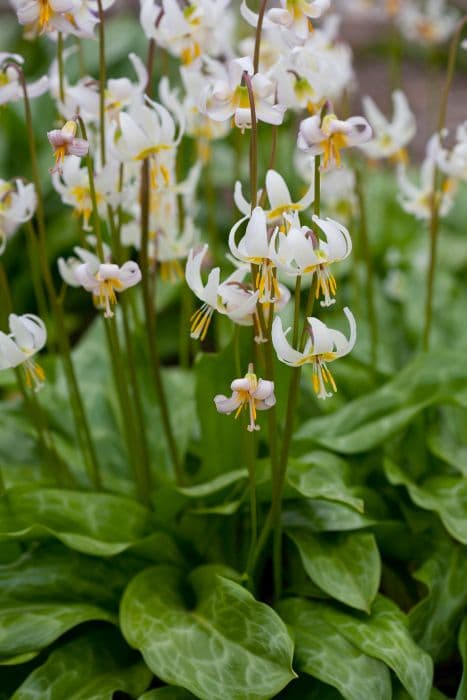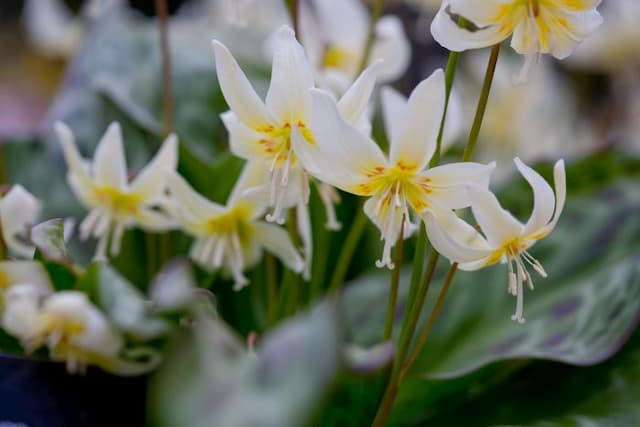Angelique Tulip Tulipa 'Angélique' (11)

ABOUT
Tulipa 'Angélique' is a distinctive plant mainly recognized for its beautiful flowers. It blooms with luxurious, peony-like blossoms. These flowers carry an exquisite pastel pink hue, often displaying various shades from pale to a more intense soft pink. The petals give a multi-layered, fluffy look which makes them appear very full and lush. They may show a slight gradient in color, starting lighter at the base and deepening as they extend outward. The edges of the petals can appear slightly fringed, adding to their delicate appeal. The foliage of the plant is a rich green color, with leaves that are broad at the base, typically growing in a clump. The leaves have a smooth, sometimes glossy, finish which contrasts nicely against the softness of the flower petals. As the leaves reach up from the base of the plant, they embrace the stems that hold the flowers. As it is customary with many blooms of this type, the flowers emerge from sturdy stems, which extend out of the foliage while the plant is in bloom. The blossoms are structured in such a way that they usually face upwards, greeting the sky, which makes them very attractive when in full bloom, showing off their unique beauty. The tulip's overall appearance is one of elegance and romance, frequently making it a sought-after choice for gardens aiming to create a soft, whimsical aesthetic.
About this plant
 Names
NamesFamily
Liliaceae
Synonyms
Angelique Tulip, Double Late Tulip, Peony Tulip
Common names
Tulipa 'Angélique'
 Toxicity
ToxicityTo humans
Tulip 'Angélique' is considered to have low toxicity for humans. However, ingesting any parts of the tulip can cause mild to moderate symptoms such as vomiting, diarrhea, or dizziness. Large quantities may require medical attention due to these gastrointestinal effects.
To pets
Tulip 'Angélique' is toxic to pets, particularly cats and dogs. The bulb is the most poisonous part. If a pet ingests any part of the tulip, they may experience symptoms such as vomiting, diarrhea, depression, and hypersalivation. In severe cases, ingestion can lead to increased heart rate and changes in breathing. Immediate veterinary care is recommended if a pet consumes any part of a tulip plant.
 Characteristics
CharacteristicsLife cycle
Perennials
Foliage type
Deciduous
Color of leaves
Green
Flower color
Pink
Height
1-2 feet (30-60 cm)
Spread
4-6 inches (10-15 cm)
Plant type
Bulb
Hardiness zones
3-8
Native area
Central Asia
Benefits
 General Benefits
General Benefits- Enhances Landscape Aesthetics: With its soft pink, multi-petaled blooms, the 'Angélique' tulip adds a romantic charm to spring gardens.
- Attracts Pollinators: Tulips provide necessary nectar and pollen for bees and other pollinating insects early in the season.
- Easy to Grow: This particular tulip variety is not difficult to cultivate and can thrive in a range of garden conditions with proper care.
- Long Blooming Period: 'Angélique' tulips have a relatively long flowering time compared to other spring bulbs, offering a prolonged display of color.
- Cut Flower Usage: The blooms are sturdy and long-lasting when cut, making them perfect for bouquets and floral arrangements.
- Spring Bloom Indicator: Tulips are amongst the first flowers to bloom in spring, signaling the end of winter and the beginning of a new growth season.
- Versatile Planting: They can be planted in flowerbeds, borders, and containers, providing flexibility in garden design and space utilization.
- Resistant to Deer: These tulips are generally resistant to deer, which can be beneficial in areas where deer browsing is a problem.
- Multiplication Over Years: When cared for properly, 'Angélique' tulips can naturalize and multiply, providing more blooms in subsequent years without additional planting.
- Diverse Landscape Integration: The pastel hues of 'Angélique' blend well with various other spring bloomers, allowing for beautiful multi-species displays.
- Seasonal Color Transition: They help create a seamless color transition in the landscape from the early to late stages of spring.
 Medical Properties
Medical PropertiesThis plant is not used for medical purposes.
 Air-purifying Qualities
Air-purifying QualitiesThis plant is not specifically known for air purifying qualities.
 Other Uses
Other Uses- Tulip 'Angélique' petals can be used as a natural dye for fabrics, imparting a soft, yellow-green hue when used in the dyeing process.
- Crafted into a biodegradable confetti, the petals of the Tulip 'Angélique' add elegance and color to celebrations while being environmentally friendly.
- The sturdy stems of Tulip 'Angélique' can be used in floral arts and crafts, such as making wreaths or as structural support in large floral arrangements.
- Tulip 'Angélique' petals can be pressed and used in decorative stationary, creating unique patterns and textures for custom invitations and cards.
- Blossoms of the Tulip 'Angélique' can be floated in bowls of water as a simple and elegant centerpiece for spring-themed events or table settings.
- As a natural source of color, the petals of the Tulip 'Angélique' can be used in art projects, such as eco-printing on paper or canvas.
- The bulb of the Tulip 'Angélique' can be used in educational settings to demonstrate plant growth and bulb anatomy to students.
- During blooming season, Tulip 'Angélique' can serve as a natural indicator of spring's arrival for phenological studies tracking seasonal changes.
- The vibrant and distinctive color of Tulip 'Angélique' petals can inspire designers and artists in their color palettes for fashion, interior design, and visual arts.
- Used in a potpourri mix, dried Tulip 'Angélique' petals can add both fragrance and color, creating a unique and aromatic home decoration.
Interesting Facts
 Feng Shui
Feng ShuiThe Tulip is not used in Feng Shui practice.
 Zodiac Sign Compitability
Zodiac Sign CompitabilityThe Tulip is not used in astrology practice.
 Plant Symbolism
Plant Symbolism- Elegance: With its lush, peony-like blossoms, Angelique tulip symbolizes elegance and grace.
- Feminine Beauty: Its soft pink hues and delicate form are often associated with feminine beauty and gentility.
- Perfect Love: As a tulip variety, it conveys deep, enduring love, often thought to be flawless and ideal.
- Renewal: Blooming in spring, Angelique tulips are emblematic of rebirth and new beginnings.
- Wealth and Prosperity: Historically, tulips were highly valued and can represent abundance.
- Transience of Life: The flower's brief bloom period can also symbolize the fleeting nature of existence.
 Water
WaterAngelique Tulips should be watered thoroughly when the top inch of soil feels dry to the touch, which typically means once a week. During their growing season in spring, ensure they receive approximately one inch of water weekly, including rainfall. Increase watering if there are extended periods of hot or dry weather. Avoid overwatering, as this can lead to bulb rot. A deep, slow watering method is preferable to encourage strong root growth; you can achieve this by using a soaker hose or drip irrigation for optimal results.
 Light
LightAngelique Tulip thrives in full sunlight, meaning at least six hours of direct sunlight a day is ideal. Plant the bulbs in a spot that receives plenty of morning light, which is gentler than the harsh afternoon sun, although they can tolerate full sun throughout the day if necessary. Avoid planting in areas that are shaded most of the day, as insufficient light can lead to poor bloom development.
 Temperature
TemperatureAngelique Tulips prefer a temperate climate with chilly winters, as the bulbs require a cold dormancy period to bloom well in the spring. They can survive winter temperatures down to about -40 degrees Fahrenheit and summer temperatures up to 90 degrees Fahrenheit. However, the ideal temperature for Tulipa 'Angélique' during their growing season is between 60 and 70 degrees Fahrenheit. Ensure the bulbs are planted at a depth that provides insulation against temperature extremes.
 Pruning
PruningPruning Angelique Tulips involves deadheading the spent blooms after flowering to redirect energy back to the bulb rather than seed production. Remove only the faded flowers and leave the foliage in place until it turns yellow and dies back naturally. This typically occurs once a year, after the blooming season is over in late spring or early summer. Pruning at this time allows the plant to store more energy for the next year's growth.
 Cleaning
CleaningAs needed
 Soil
SoilAngelique tulips thrive in a well-draining soil mix that is fertile and neutral to slightly acidic in pH, ideally between 6.0 and 7.0. The best soil mix for these tulips would consist of equal parts garden soil, compost, and sharp sand to ensure proper drainage and fertility.
 Repotting
RepottingAngelique tulips are usually grown from bulbs and do not require repotting. Instead, the bulbs should be planted annually in the fall, approximately 6-8 weeks before a hard frost, and then removed from the ground once the foliage has died back in late spring or early summer for storage, or left to naturalize if conditions are suitable.
 Humidity & Misting
Humidity & MistingAngelique tulips do not require specific humidity levels as they are not grown indoors. They are able to tolerate the natural outdoor humidity conditions in the regions they can grow, so maintaining a particular humidity level is not necessary.
 Suitable locations
Suitable locationsIndoor
Plant bulbs in pots with drainage; give ample light and water sparingly.
Outdoor
Plant bulbs 6-8 inches deep in fertile, well-drained soil in autumn.
Hardiness zone
3-8 USDA
 Life cycle
Life cycleThe Angélique tulip begins its life as a bulb, which is typically planted in the fall before the ground freezes. After a winter dormancy period, the bulb sprouts in early spring, sending up a stem and leaves as temperatures rise. The plant enters its flowering stage in mid to late spring, during which it displays its distinctive double-pink petals and emits a light fragrance. Once the flowering period ends, the petals wilt and the plant enters the senescence phase where the foliage yellows and dies back. The bulb then goes into a summer dormancy period, conserving energy for the next growing season. The life cycle is repeated annually, with the bulb producing new offsets or daughter bulbs as it matures, thus expanding the cluster of plants over time.
 Propogation
PropogationPropogation time
Spring
The most popular method for propagating Tulip 'Angélique' is through division of its bulbs. The best time for this process is in the fall, after the leaves have died back and the bulbs have entered a period of dormancy. To propagate, carefully unearth the bulbs and gently separate the smaller offsets, which are the bulblets that form around the base of the mother bulb. These bulblets can be replanted immediately at a depth of around 6 to 8 inches (15 to 20 centimeters), ideally in a well-draining, fertile soil with good exposure to sunlight. Over time, these offsets will mature into blooming bulbs, perpetuating the beauty of the 'Angélique' tulips in the garden.








